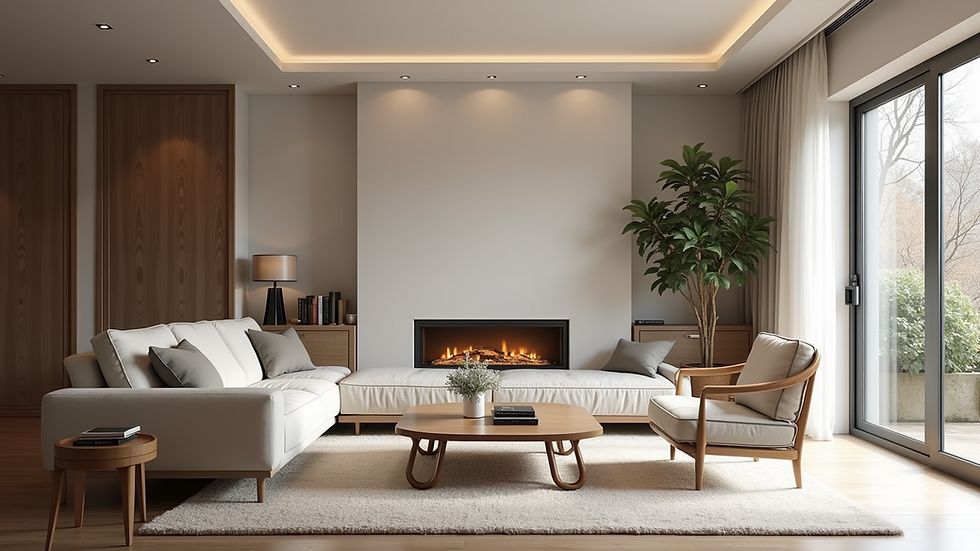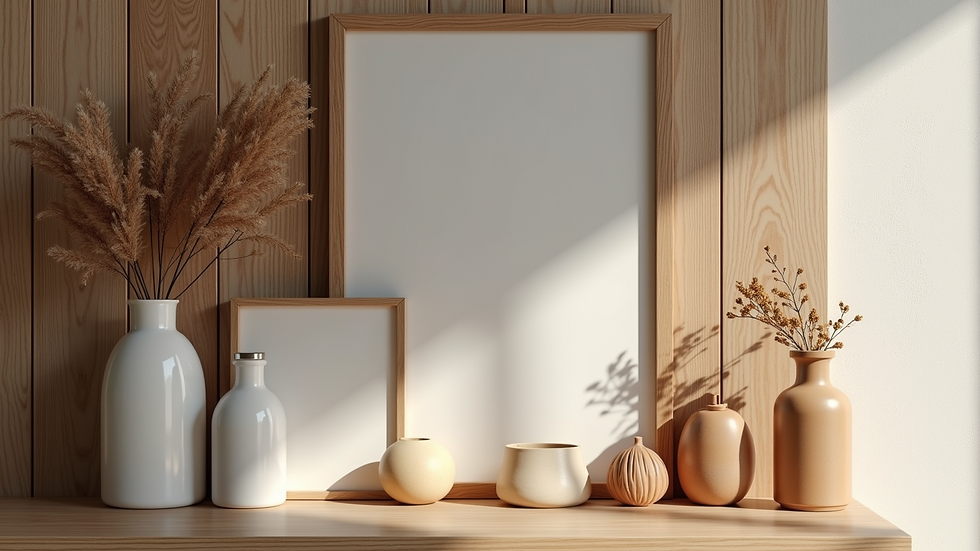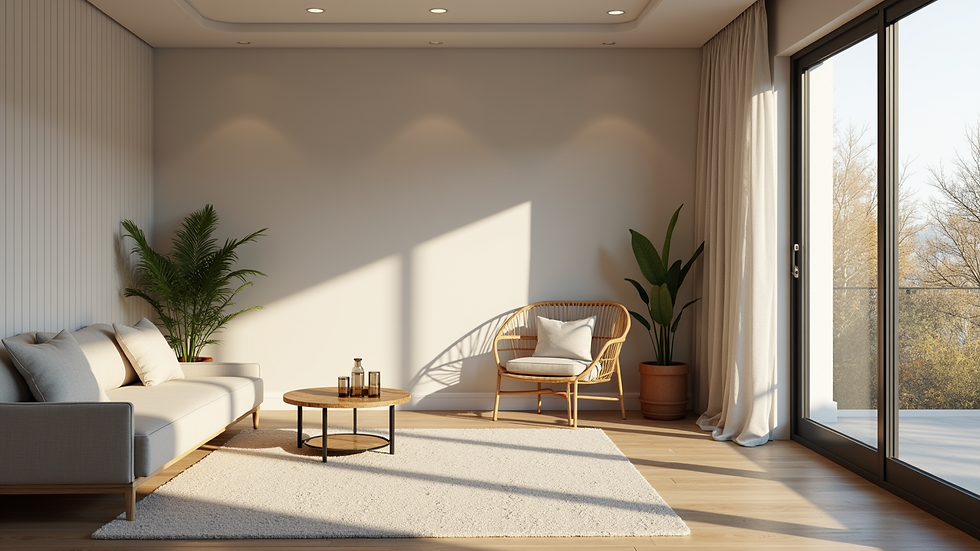How to Blend Modern and Traditional Styles
- Samuel B.
- Aug 16, 2025
- 5 min read
Updated: Aug 19, 2025
Blending modern and traditional styles in design creates a unique aesthetic that captures contemporary trends and timeless elegance. Whether you’re decorating your home, planning an event, or designing a product, knowing how to merge these two styles can elevate your project significantly. This blog post will explore effective strategies for combining modern and traditional designs, ensuring that your work is not only functional but also visually striking. If you’re considering a larger remodel, check DBG Contracting’s Home Renovation services to see how professionals can help bring your vision to life.
Understanding Modern and Traditional Styles
To blend modern and traditional styles effectively, we must first recognize their distinct characteristics.
Characteristics of Modern Style
Modern design emphasizes clean lines, minimalism, and functionality. Key features include the use of materials like glass, metal, and concrete, which foster open spaces and enhance natural light. A neutral color palette—often whites, grays, and beiges—forms the base, accented with bold colors that add interest without overwhelming. Notably, modern design increasingly incorporates sustainable practices and innovative technologies, aligning with today’s eco-friendly trends.
Characteristics of Traditional Style
In contrast, traditional design draws from historical influences, emphasizing craftsmanship and comfort. It features ornate details, rich textures, and a warm color palette. Spaces styled traditionally are typically more formal and can include elements like crown molding, wainscoting, and antique furniture. This style promotes a sense of comfort and nostalgia, often showcasing heirlooms and classic patterns. For custom trim, built-ins, or bespoke cabinetry that bridge both aesthetics, see DBG’s Millwork offerings.
Finding Common Ground
To merge modern and traditional styles successfully, identifying common elements is key. Here are practical strategies:
Color Palette
A cohesive color palette serves as an effective blending tool. Start with a neutral base that reflects modern sensibilities—think whites, grays, and beiges. Then, introduce traditional colors through accents like textiles or decorative items. For instance, use a beige sofa with colorful throw pillows featuring traditional floral patterns. This balance allows contemporary vibes while embracing the warmth of classic hues. If paint is part of the plan, DBG’s Painting team can help choose and apply finishes that read well across styles.
Textures and Materials
Combining various textures and materials can create depth and visual interest. For example, contrast sleek metal furniture, such as a chrome dining table, with traditional upholstered chairs in rich fabrics. Incorporating natural materials—like a reclaimed wood accent wall or stone elements—can reflect both design styles beautifully. This approach not only enhances aesthetics but also invites tactile interaction. Don’t overlook how flooring anchors the look; DBG’s Flooring services offer options that work with both modern and traditional schemes.

Furniture Selection
When choosing furniture, seek pieces that embody both styles. A modern coffee table with clean lines pairs well with a traditional sofa featuring intricate patterns. For example, a sleek glass dining table can complement ornate wooden chairs, striking a balance between old-world charm and modern sophistication. Opt for furniture that has a timeless quality, ensuring seamless integration into your design. If your project includes kitchen or bathroom updates, align cabinetry and fixtures with DBG’s Kitchen and Bathroom remodeling services to ensure a cohesive result.
Incorporating Art and Decor
Art and decor significantly shape a space's overall style. Here’s how to integrate both modern and traditional influences effectively:
Artwork
Select artwork that resonates with both styles. Abstract pieces, such as minimalist prints, can enhance modern elements, while classic landscapes or portraits introduce a traditional touch. Creating a gallery wall that showcases a mix of art styles and frames—like modern metal frames alongside vintage wooden ones—adds character and visual intrigue to your space.
Decorative Accessories
Accessorizing is essential for achieving a balanced look. Incorporate modern accessories, such as simple vases or geometric sculptures, next to traditional items like ornate candlesticks or vintage books. For example, placing a sleek ceramic vase on a traditional wooden side table creates visual balance and interest. This mix fosters a curated feel, encouraging each piece to shine while contributing to the overall design.

Lighting Choices
Lighting significantly affects a space's ambiance, so consider the following strategies when blending styles:
Statement Fixtures
Select lighting fixtures that can serve as statement pieces. For example, a modern pendant light can elevate a traditional dining room, bringing contemporary flair to the space. Alternatively, a classic chandelier can enhance a modern kitchen, creating an inviting atmosphere. The goal is to choose fixtures that harmonize with both styles without overpowering the overall design.
Layered Lighting
Incorporating layered lighting adds depth and warmth. Combine ambient, task, and accent lighting to create a well-lit environment. Use recessed lighting alongside stylish floor lamps or table lamps to highlight different areas. This dynamic interplay encourages a seamless integration of modern and traditional elements while enhancing functionality.
Creating Balance
Maintaining balance is crucial when merging modern and traditional styles. Here are effective strategies to achieve this:
Proportion and Scale
Pay attention to the proportion and scale of furniture and decor. Large traditional pieces, like a grand piano, can dominate a room. Consider using smaller modern items, such as minimalist stools, to maintain balance. Conversely, oversized modern furniture may need grounding traditional elements, like a richly textured area rug, to avoid feeling stark.
Focal Points
Establish focal points that guide the eye and unify the space. This can be a striking piece of art, a beautifully designed fireplace, or a unique piece of furniture, such as an antique sideboard. A strong focal point can highlight the harmonious blend of styles, allowing them to complement rather than overshadow each other.
Adding Your Unique Touches
The best designs reflect your personality and preferences. Here are ways to include personal touches in your blended style:
Heirlooms and Personal Collections
Integrate family heirlooms or personal collections that hold sentimental value. These items can serve as conversation starters and add a layer of history to your design. Whether it’s a vintage clock or art passed down through generations, these elements can seamlessly blend with modern decor, allowing for rich storytelling within your space.
Customization
Explore customization options for furniture and decor to better align with your vision. This might involve reupholstering a traditional chair in a bold modern fabric or commissioning artwork that combines both styles. Customization empowers you to create a space that authentically reflects your unique taste and aesthetic preferences. DBG’s Millwork team to create one-of-a-kind elements.
Final Thoughts
Blending modern and traditional styles is an art that involves thoughtful consideration and creativity. Understanding the characteristics of each style, pinpointing common ground, and incorporating personal touches allow you to create a harmonious and inviting space that reflects your aesthetic. With a strong focus on balance, proportion, and the careful selection of colors, textures, and decor, you can successfully merge modern and traditional designs into something truly remarkable. If you want to extend the look outdoors, consider transitions to Decks to connect interior and exterior spaces.
If you’d like professional help executing this mix of styles, visit DBG Contracting’s Services page and schedule a consultation — we’ll help you design a space that feels both current and timeless.




